"Tin-Canning" Submarine Hull: Does Anyone Know How to Do It? Need Some Feedback?
1st thing I would like to say is "These are not my models". They are the pictures of a model I-400 JPN Sub made by "Hyun Soo Kin". I am making the same model using the Tamiya 1/350 I-400 Sub model. I also have the Infinity Detail-Up PE kit with wooden deck, and turned brass pieces.
I have always been a huge fan of ship models that re-create the "tin-canning" effect often seen on actual Naval Vessels including war ships, and subs. For me it is a huge visual aspect of the real 1:1 vessel which is rarely replicated in models. I have seen some model makers try to create this on aircraft skins were they actually grind away between the riveted panels. It looks very dangerous to attempt and seems to be a huge time commitment. I want to know how I can do this using just paints, and weathering products. I have attempted many advanced techniques and have had much success with creating visually exciting surfaces but have not done, nor attempted to create, a "tin-canning" surface look.
So, you can see on the included pictures of the I-400 that the model maker succeeded in creating this look. I am not sure how they did it. Maybe some of you know how, and/or have been successful in creating this look on some of your models. I would love to hear your ideas, comments, suggestions, and feedback. Or can you point out any videos which may already exist which illustrate this process. I have looked and have not found anything to similar.
It is really important that I get this right because it is requested by a customer who has commissioned this build, and supplied me with the actual kit, and all the extras. I know I can create a nice looking, realistically weathered sub model, but it would be missing this effect.
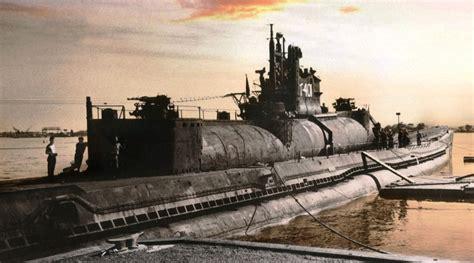
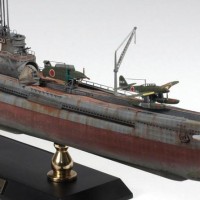


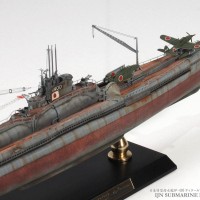
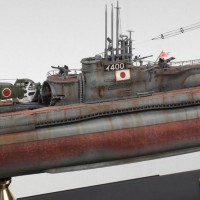
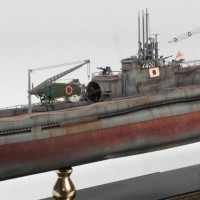
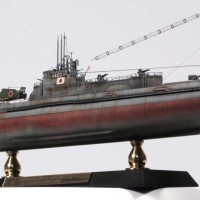
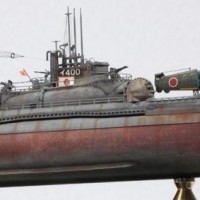
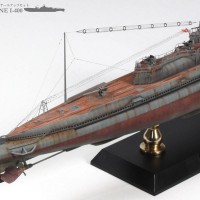
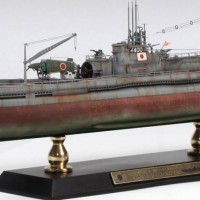
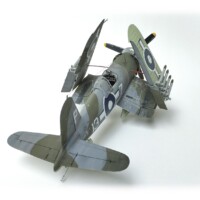
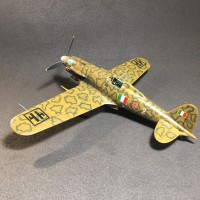
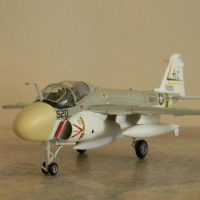
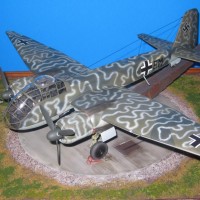
This is pretty amazing work, but I would have to say that - in 1/350 - it is the "tin-canning" equivalent of an extreme version of "Spanish school" painting, i.e., that cartoonish look that has nothing to do with any reality anywhere ever. I've been around ships and have never seen such a look as this in the real world. In 1/350, a "realistic" version of this effect would be almost un-noticeable. If you want to do it with paint for a visual effect, I'd suggest a version of what you did with the sun-faded SBD - just a "Spanish school" paint job.
I'm sure the master shipbuilders here may have other ideas. This is an amazing model, but it doesn't say "realistic" to me.
I hear what you are saying. Some of the things we do to create visual interest do not 100% represent what is happening in the real world. Painters do not modulate paint jobs on real tanks, planes, and ships. But real vehicles have something visual going on that a scale model just does not capture. Real objects at full size play with the light and the shadows in a way that a scale model does not. IMHO without any effect I feel that this results in a scale model looking like a toy in many ways, or looking 10" instead of 100'. Before I ever got into this technique I really felt my models were "blah" looking and looked like a model, fake sort of. The paint was so mono-chromatic and just out of scale. I feel my models are so much more lifelike, interesting, and provide that "thing" that is missing from scale models. It may be more on the artistic side then realistic side when you analyze it from a scientific perspective with accurate measurements, and such. I try to capture the "spirit" of how the object is perceived to the human eye. But when you take it in as a "whole" it just speaks more to the viewer that something real is going on. Its a trick or perception of the mind, not real. Just like scribed lines are so out of scale compared to 1:1 panel lines, but without them they just dont look real. I think moderation is the key here blending in a little of the Spanish-school but not going overboard. Its also just subjective taste. I dont like plain paint jobs and just love the other look. The person who wants this sub sent me these pics and asked if I could do it. If it was just my build I would do everything he has done to the sub except try to achieve the "oil-canning".
Oh yeah, I paint the same way and agree with all this. Just also bring "moderation in all things" to the work or you end up looking like a "Spanish school" cartoon.
Here are some great real-life examples of "Oil-Canning" on a real ship.
2 attached images. Click to enlarge.
OK I am replying to myself. I found a link: http://www.shipmodels.info/mws_forum/viewtopic.php?f=4&t=158612
This describes a very simple and effective technique for Oil Canning. See pictures below.
8 attached images. Click to enlarge.
After seeing some of your work, I'm sure your result(s) will be favorable. 🙂
Paul, with respect, you’re over-thinking this. Apart from the usual highlights/lowlights a little red/orange Artists oils at given places where the ‘wear’ of the wash affects the bolts/rivets, is all you need. I must say that I too think the example you’ve led with is overstated. Less is more. A weak wash judiciously applied will add more than any number of ‘proscribed products’.
I have to agree with Tom...looking at those tutorial photos all I can see is light/shade contrast using darker or lighter hues. Call it Spanish school, call it Flemish school, modulation, whatever...to me the same painting techniques meant to create depth and the false perception of dimension. It is quite effective (and some of your models are the proof of this) but often overdone IMO but that’s just a matter of personal taste.
And by the way wasn’t that sub built (and its sister ship) in the last weeks of the war going on a one way trip mission to bomb the US Pacific coast and half way Pacific came Japan’s surrender? That model is one awesome model (just mind blowing details!) but the worn effects might be a little too heavy if so.
You've nailed it. The only one that actually went to sea was the I-400 itself and it saw no action.
Hi Paul,
I got my hands on a German modeling magazine recently with exactly this kind of issue in a special article. I will look it up for you and send it.
Send me a PM with your email and then I will scan it and send to you, ok? If you like, I'll help you translating it.
Cheers, Michel.
Thanx Michel I will PM u.
After seeing the pics above I think the technique is perhaps over done though that will always be a matter for debate as most of us will have seen real examples of this look I would say it comes in the end to personal preference. But if it's what the customer wants fair enough.
Well, he said he wants to use those pictures as a reference. I am not sure how exact he wants me to get to that exact model. That needs to be explored further with him prior to painting. After all I have a personal style of modeling and it may not replicate the above modeler in every way. I built a U-Boat for him and I did not go to this extent regarding hull detail. He is example of what I provided with the U-Boat.
5 attached images. Click to enlarge.
Consider going for a more subtle effect for this boat. The images I've seen of IJN submarines hadn't revealed a lot of the oil canning effect.
http://warfarehistorynetwork.com/wp-content/uploads/Q-I-400-4-HT-Win12.jpg
http://warfarehistorynetwork.com/wp-content/uploads/Q-I-400-1-HT-Win12.jpg
http://warfarehistorynetwork.com/wp-content/uploads/Q-I-400-6-HT-Win12.jpg
But as mentioned before, it's what the customer wants.
Well, he said he wants to use those pictures as a reference. I am not sure how exact he wants me to get to that exact model. That needs to be explored further with him prior to painting. After all I have a personal style of modeling and it may not replicate the above modeler in every way. I built a U-Boat for him and I did not go to this extent regarding hull detail.
Have those pictures as a reference but could not get much from them due to quality, light, and angle. I think most ships/subs I have seen from that era have some level of Oil-Canning, but its a matter of how much it really shows up in pictures, and how to capture w/o over-doing. See above U-Boat pics of model I made and how I tried to capture some of this but not as consistent and over-stated.
Hi Paul, of the two 'realistic' photos, only the second (793) is worth using as a reference. The first is a product of heavy digital processing and as such does not represent a realistic view. It has probably been created using a High Dynamic Range (HDR) processing programme - used well it can create images much closer to what the eye sees (as opposed to what the camera captures). However this is not a great photo in that respect. HDR is often used to produced a 'fantasy' image with areas of high local contrast. It will have exaggerated the areas of shadow and light. There is also an unrealistic colour caste.
All that said, if the research shows this to be in effect on the boat then I think it is worth pursuing - the only observation I could make is that on the tutorial the pictures show a very uniform paint job depicting the oil-canning and the photos show it to be a far from uniform effect.
Interesting observations, but growing up near a large naval base I saw many of these destroyers and various warships with very pronounced oil-canning. I think this is why I always want to portray in my modeling; its the way I experienced these mighty ships.
Absolutely right you do it the way you want!
I don't think you can really go that wrong Paul. The two real example photos you posted really say it all. They might be towards the more extreme as examples but that gives you plenty of scope to subtly vary the technique in the model example you posted.
Illegitimi non carborundum.
It´s a plastic model. Build it and paint it any way you want it, especially if it is for a client.
Something to keep in mind is that this effect is not found on all ships - it varies widely by construction methods and materials. In the USN, I saw this often on older DD's but rarely saw it on newer classes of ships. It was non-existent on my last ship, the USS Eisenhower, and I don't recall seeing this on any of the SSN's I spent time on. I spent a brief time aboard the HMS Manchester and want to say that I remember her having the dimpling. Anyway, I agree with the other guys - this effect would probably be best achieved with paint, especially in this scale. I have a friend who does this "stressed skin" effect on his WWII aircraft. He actually scrapes out troughs on the skin between the underlying structures with a scalpel. It's a ridiculous amount of work and when I look at the finished result, even though it's masterfully done, I just don't know if it passes my BS filter. I appreciate the craftsmanship, but there's an unrealistic quality to it.
In the end, the customer is always right so give him what he's asked for. 🙂
Good luck with your project.